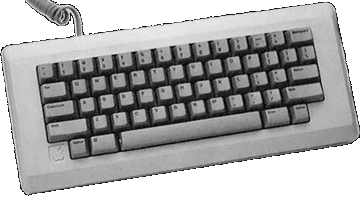Apple /// & ///+

Essentials
Family: Pre-Macintosh
Codename: Sara
Introduced: June 1980
Terminated: 1985
Processor
CPU: SynerTek 6502A
CPU Speed: 2 MHz
FPU: none
Bus Speed: 2 MHz
Register Width: 8-bit
Data Bus Width: 8-bit
Address Bus Width: 16-bit
ROM: 4 kB
Onboard RAM: 128 kB (256 kB in revised and IIIplus)
Maximum RAM: 512 kB
Expansion Slots: 4 proprietary (compatible w/ Apple II)
Video
Max Resolution: 80x24 text, 1 bit (B&W) 560x192, 4-bit 280x192
Storage
Floppy Drive: built-in Shugart 143 kB 5.25"
Input/Output
Serial: 2 RS-232
Speaker: mono
Miscellaneous
Dimensions: 6.25" H x 17.5" W x 18" D
Weight: 25 lbs.

The Apple /// was announced in June 1980. It contained a Synertek 8-bit 6502A processor which could run at speeds up to 2 MHz. It contained 128K of RAM and a 4K ROM. It could run most Apple II programs through emulation, and came with a sophisticated new operating system. It was the first Apple to include a built-in 5.25" disk drive, and hi-res graphics built-in to the motherboard. It was designed to be Apple's business offering, but sold very poorly. It sold initially for between $4,340 and $7,800, depending on the configuration. The original Apple III had many problems, and was replaced by a revised model in mid 1981, which featured 256K RAM, updated system software, and a lower price ($3495). A 5 MB external hard disk was also made available. The Apple /// sold very poorly and was replaced by the Apple ///+ ($2995) in Late 1983. The Apple ///+ was discontinued in 1985.
Picture Credits:
Old Computers
Date: Wed, 05 Mar 1997 02:03:37 -0800
From: John Huber
Subject: Apple History
Here's another tidbit you might add: Rupert Lissner wrote a program for the Apple ///, called 3-EZ Pieces (I might be spelling it wrong). It combined spreadsheet, database, and word processing -- and was probably the first "works" program. Of course, like the Apple ///, it didn't sell well. However, when the Apple ][e was introduced, so was a new version of Lissner's (come to think of it, I might be spelling his name wrong, too) software, as AppleWorks. It became the biggest-selling software package of all time, and Rupert became rich. He bought a red Ferrari and a vanity licence plate reading "MIO POMO" (my apple).
- John Huber, Apple employee 1982-1994
Date: Tue, 02 Aug 2005 19:08:56 -0700
From: Antonio Rodríguez
Subject: Apple ///
It's little known, but the Apple /// could do color graphics when connected to a color display. In that case, it could do 4-bit (16 colors) 40x48 and 140x192.
Date: Wed, 14 Sep 2005 05:09:28 -0700
From: Daniel Shirah
Subject: Apple ///
One of the Apple ///'s many problems was its poor ventilation. The heat often caused the logic boards to warp, which resulted in the chips coming loose from the board. It is reported that when one called Apple to report this problem, they actually suggested you pick the computer up and drop it a few inches from the ground. Good old fashioned way of fixing things... nice to hear a story like that when nearly all tech help today is actually no help at all.
Date: Wed, 15 Apr 2009 10:36:23 -0700
From: Oscar
Subject: Apple ///
The Apple /// problem that involved lifting the machine and dropping it was because the chips became loose during shipping. It was not a heat related problem.
I worked at the Byte Shop in Seattle for the Terrells in 1980 doing sales. When we received our ///, it was an out of the box failure. When another salesman lifted the front of the machine and dropped it, it reseated the chips and the machine worked with no problem. I have never seen one with that problem because of heat issues.
I even sold an Apple ///, that very day and the purchaser never reported a problem with the machine that was related to heat.
